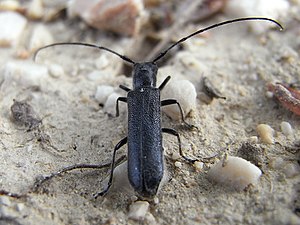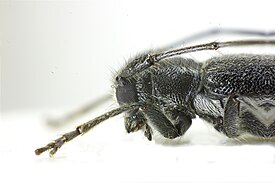Metal-colored basswood
| Metal-colored basswood | ||||||||||||
|---|---|---|---|---|---|---|---|---|---|---|---|---|

Metal- |
||||||||||||
| Systematics | ||||||||||||
|
||||||||||||
| Scientific name | ||||||||||||
| Stenostole dubia | ||||||||||||
| ( Laicharting , 1784) |
The metal rose Linde Bock ( Steno stole dubia ) is a beetle from the family of the longhorn beetle and the subfamily Lamiinae . It is mainly found on linden trees and the wing covers have a more intense metallic sheen than the very similar species Stenostola ferrea .
 Fig. 1: Head Fig. 2: Wing cover, tip  |
 Fig. 4: Claw hind leg Fig. 5: Wing cover, base  |
 Fig. 3: Side view of the head and chest |
|
Characteristics of the beetle
The body is black, the dark wing covers have a metallic green-blue shine. The beetle reaches a length of ten to thirteen millimeters.
The head is tilted downwards. The mouthparts point downwards, the last link of the jaw probe is pointed. The eleven-link, thin antennae have long eyelash hairs (Fig. 3). The antennae are colored the same over their entire length, so the antennae do not appear ringed. The compound eyes are kidney-shaped and nestle against the antenna base from behind (Fig. 1).
The side of the pronotum is not completely hairy, only indistinctly white on the edge (Fig. 3).
The long wing-coverts have roughly parallel sides, but are slightly bulbous before the end. The ends are individually rounded (Fig. 2). The elytra are roughly punctured (Fig. 5), coarser than in the similar species Stenostola ferrea . In addition, the hairiness of the elytra is less dense and longer than in Stenostola ferrea .
The tarsi The five-part tarsi appear to be four-part (pseudotetramer), as the fourth part is very small and hidden between the lobes of the third part. The claws have a clear tooth at the base (Fig. 4).
biology
The larva develops mainly in linden and hazelnut , also willow , poplar , hornbeam and elm are mentioned. For development, dying branches or dead branches with residual moisture, such as branches lying on the ground, are required. The affected branches are two to five centimeters in diameter. The adult beetle can mainly be found on the breeding trees from May and July.
distribution
The metal-colored basswood is widespread in Europe, more common to common in the south and rare in the north. The distribution area extends from Spain to the Ukraine and from Italy to Norway and Sweden . The species is absent in Greece , Romania and Great Britain .
Individual evidence
- ↑ a b Stenostola dubia in Fauna Europaea. Retrieved December 18, 2010
literature
- H. Joy, KW Harde, GA Lohse: The Beetles of Central Europe. Volume 9, Spektrum Akademischer Verlag, Munich 1966, ISBN 3-827-40683-8 .
- Adolf Horion : Faunistics of the Central European beetles. Vol. XII, Überlingen-Bodensee 1974.